Samsung Galaxy S 4 Review - Part 1
by Brian Klug on April 24, 2013 12:01 AM ESTBattery Life and Charge Time
The Galaxy S 4 features a removable 9.88Wh battery with 3.8V chemistry. The battery design is par for the course for any high end smartphone, but the fact that it's removable remains a staple of the Galaxy S design. Whether or not the bulk of consumers actually use the flexiblity offered by a removable battery is up for debate, but there's no doubt about the fact that Samsung has a strong following of users who appreciate the feature.
Unfortunately, only having access to the Sprint version of the Galaxy S 4 to review, most of our battery life tests on the cellular network aren't all that useful. The good news is that our WiFi tests should at least give you an idea of how well the SGS4 will compare to the HTC One when both are on the same network. We're using the latest revision of our smartphone battery life test to compare performance of all the key players here. This is now our sixth revision of the battery life test, and we feel is the optimal balance between challenging workloads and idle time. The basic overview is the same as the previous test — we load webpages at a fixed interval until the handset dies, with display set at exactly 200 nits as always. Power saving features are disabled if they turn on automatically, and background account sync is disabled. The test is performed over both cellular data on all available air interfaces and over WiFi in an environment with good signal levels. The new test has decreased pause time between web page loads and added a number of JavaScript-heavy pages. I sat down with some UMTS RRC (Radio Resource Control) emulator tools and also made sure we had a good balance of all the RRC states (DCH, PCH if possible, FACH, IDLE) so we weren’t heavily biased towards one mode or the other.
As the most relevant comparison of platforms we have today, we'll start with the WiFi version of our web browsing test:
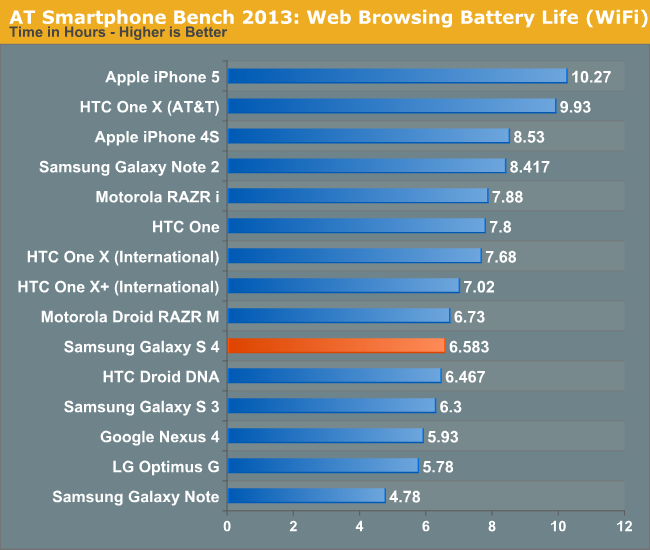
On WiFi the Galaxy S 4 falls behind the HTC One by an appreciable amount, however there's still an improvement in battery life compared to the Galaxy S 3. The Galaxy S 4's battery life isn't bad by any means, but do keep in mind that this is a large phone with a large display and a very powerful SoC. For much of the past year we've been talking about an increase in dynamic range in total platform power of high end smartphones and the Galaxy S 4 is no exception. Run it at full brightness or keep many cores running in their maximum performance states for a considerable period of time and you'll be greeted by a phone that's quickly in need of a power outlet.
As I mentioned earlier, we only have access to the Sprint version of the Galaxy S 4 at this point which unfortunately means that our 3G results aren't all that comparable to other devices here.

Even on Sprint, the Galaxy S 4 does surprisingly well.
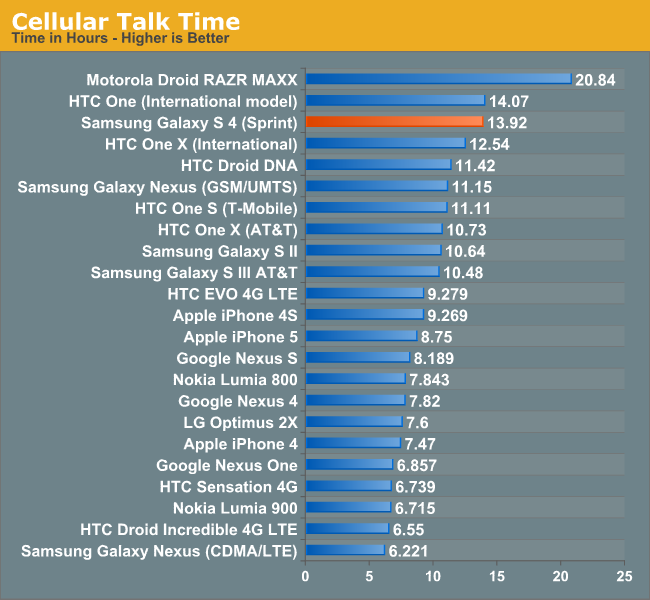
Talk time is excellent on the Galaxy S 4, with the phone delivering effectively the same battery life as the HTC One. Without having to power on that huge display, the Galaxy S 4 can last for a very long time on a single charge.
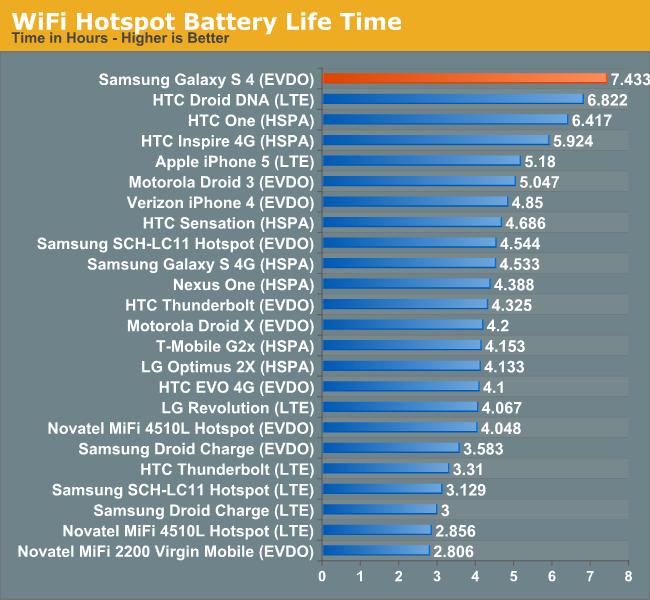
A combination of the Sprint network and the fact that the Galaxy S 4's display remains off during our hotspot test resulted in great battery life here as well. Again, this data isn't all that useful if you're not on Sprint but Samsung tells us we should be able to get our hands on an AT&T SGS4 in the not too distant future.
Charge Time
Samsung appears to implement Qualcomm's Quick Charge specification in the Galaxy S 4 and its bundled charger. I realize we haven't done a deep dive into what Quick Charge is and how it works, but I'll try to go through a quick explanation here. Most conventional chargers are linear, they take a fixed amount of input current (at 5V) and pass it along to the device being charged. The problem is that at deeply discharged states, the device's battery might be at a substantially lower voltage. A traditional linear charger won't change the current supplied based on the voltage of the battery being charged, and as a result can deliver sub-optimal charge times. When implemented, Qualcomm's Quick Charge technology can vary output current based on the voltage of the battery being charged, which results in less power being dissipated as heat and more being delivered to charging the battery itself. The table below helps illustrate the savings:
Quick Charge, at least in its currently available 1.0 specification, is still bound by the 5V limits of the USB BC 1.2 specification. The next revision of Quick Charge will enable higher voltage operation for even faster charge times.
| Qualcomm Quick Charge 1.0, Theoretical Example | ||||||
| Input Current @ Voltage | Input Power | Output Current @ Discharged Battery Voltage | Output Power | |||
| USB BC 1.2 - Linear Charger | 475mA @ 5V | 2.375W | 475mA @ 3V | 1.425W | ||
| Qualcomm Quick Charge 1.0 | 475mA @ 5V | 2.375W | 700mA @ 3V | 2.100W | ||
The non-linear nature of Quick Charge significantly shortens charge time, particularly in the very early stages of charging when the device's battery is presumably fully discharged. As the device's battery voltage increases, current delivery tapers off and the QC advantage is no longer as great as a standard USB BC 1.2 solution. The end result though is significantly improved charge times.
The graph below shows the benefits of using Samsung's own charger vs. a standard charger that implements the USB BC 1.2 specification. When used with the bundled charger, the Galaxy S 4 recharges much faster than HTC's One, despite using a larger battery. Obviously the Galaxy S 4 will charge with any USB charger, but the charge time will simply be longer. Samsung uses a voltage divider and signals the presence of their own charger by sending 1.2-1.3 V across the D+ / D- pins, this is similar to what Apple does with 2.0 or 2.8 V across the pins for various USB chargers they've shipped over the years. This signaling is essentially Samsung's proprietary tablet charging signaling which they've employed on the Galaxy Note 2 and now SGS4, in fact the two use the same exact charger, so it's worth tossing out your old ones and getting the appropriate one to take advantage of the faster charging.
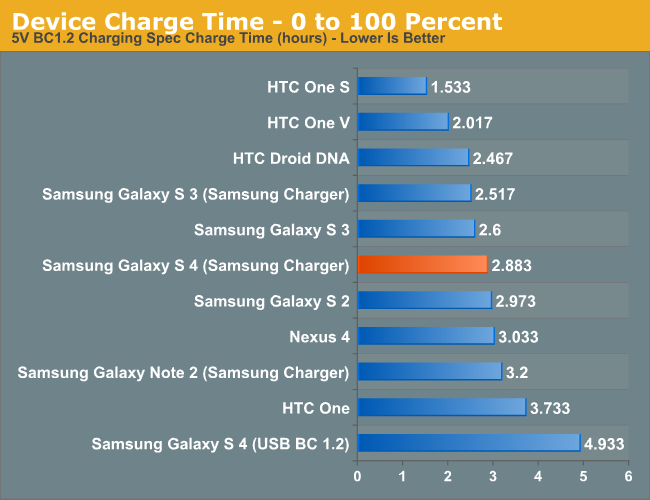


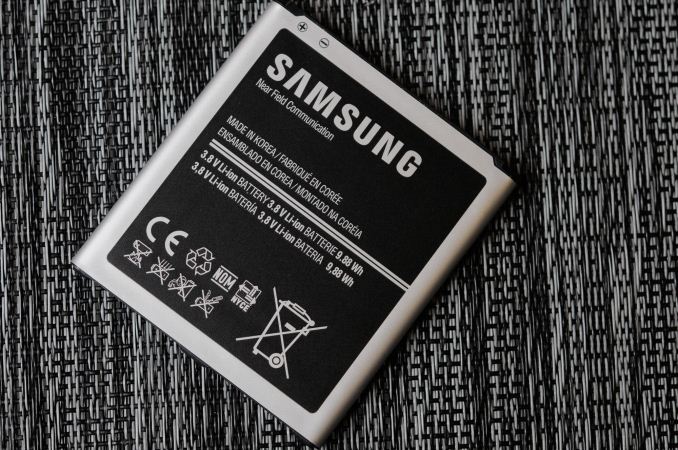








335 Comments
View All Comments
casteve - Wednesday, April 24, 2013 - link
Thanks for the review - I look forward to Part 2. Also, it's good to know the highway is clear so you can run away from the killer bee swarms.gnx - Wednesday, April 24, 2013 - link
A request to Brian Klug, and Anandtech!Any chance you'd start implementing comparisons of heat measurements for smartphones. Some of these latest flagships have so much horsepower in the them, the back cover heats up quite a bit under heavy use (not only games, but also navigation). It's almost like early light-n-thin laptops that became unusable cause of the heat on the palmrest or underbelly. Just hardware wise, such heat is detrimental to the phone itself in the long term. It could be a problem with last years flagships, so I'm guess this years ones could be more. A more strict analysis/measurement of how these smartphones manage and dissipate heat would be greatly appreciated!
Arbie - Wednesday, April 24, 2013 - link
I'm amazed that people want anything OTHER than plastic in a phone. If you go with anything metallic you have to jump through major technical hoops to get good reception. Why even consider spending all that design money, not to mention making the many unseen compromises that this involves?For me this phone hits all the right points, including these two key items:
• SD card so I can easily swap media sets in and out. Internal fixed memory can't begin to compete with with the speed, capacity, and convenience of micro/SD chips.
• Replaceable battery , so that when it eventually dies I DON'T have to send the phone in for service.
hyperdoggy - Wednesday, April 24, 2013 - link
nothing wrong with plastic, as long as it isn't fisher price plastic.eallan - Thursday, April 25, 2013 - link
which it isdyc4ha - Wednesday, April 24, 2013 - link
Internal memory is much faster than microsd, fact. It is more convenient if everything is in the same place rather than having to swap things out, no? If you really need 32/64GB+ then sure microsd might be better for you, but with USB OTG this is not a big problem at all.sigmatau - Thursday, April 25, 2013 - link
Why did they have to use the cheapest plastic found in 25 cent toys from a gumball machine? I have a plastic phone, a Nokia 900, which kills this phone and any Samsung phone made in feel and durability.superflex - Wednesday, April 24, 2013 - link
The GS4 is evolutionary, not revolutionary.Reminds me of a Cupertino company and their latest phone.
Oh, how the Sammy trolls berated them for that.
HTC One FTW
Shlong - Wednesday, April 24, 2013 - link
And the HTC One is evolutionary (compared to HTC One X).berantle - Wednesday, April 24, 2013 - link
Compared to the HTC One X (and the rest), the HTC One is revolutionary in at least a 3 ways.1. The front-facing stereo speakers. If it was evolutionary, it would have been making a better quality rear-ward facing single speaker.
2. The 4Mp UltraPixel camera. If it was evolutionary, it would have followed the herd towards 13MP camera and even smaller pixel-size sensors than the 8MP camera.
3. The HTC Zoe (which I understand is short for "Zoetrope"). Automatically packaging short movies and photos taken into a simple 30 second presentation. You don't find that with other phones as best as I can see to-date. This is a big change from how it is done by cameras. Reading the reviews of the S4 here and elsewhere, what the S4 is doing seems like a belated response after seeing what the HTC One could do. A lot of people were caught flatfooted by what the HTC Zoe could do.
These are 3 main revolutionary things that the HTC One has done. The S4? I can't see anything revolutionary. The Samsung Galaxy S4 is all about putting everything but the kitchen sink into it. If Samsung could shoehorn the kitchen sink into the S4, they would do it too - just to boast that it has a kitchen sink and no other phone has it.